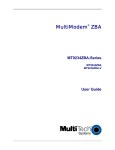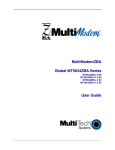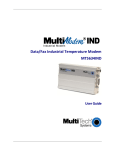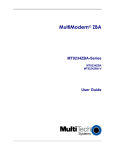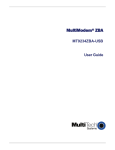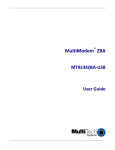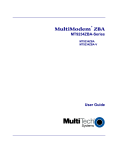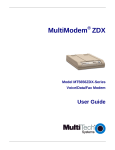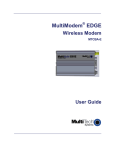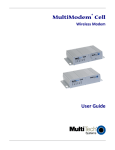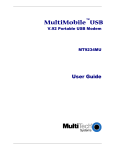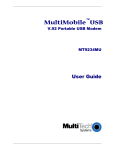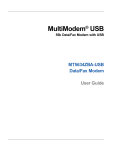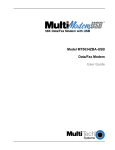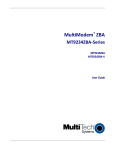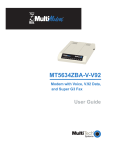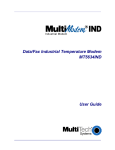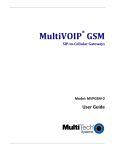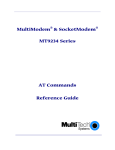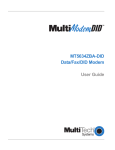Download Multitech MultiModem MT5634ZBA-V-V92 User guide
Transcript
MultiModem® ZBA MT5634ZBA-Series MT5634ZBA MT5634ZBA MT5634ZBA-Global MT5634ZBA-V92 MT5634ZBA-V-V92 User Guide Copyright and Technical Support MultiModem ZBA MT5634ZBA-Series User Guide MT5634ZBA, MT5634ZBA-Global, MT5634ZBA–V.92, MT5634ZBA-V–V.92 PN S000286H, Version H Copyright This publication may not be reproduced, in whole or in part, without prior expressed written permission from Multi-Tech Systems, Inc. All rights reserved. Copyright © 2003-11, by Multi-Tech Systems, Inc. Multi-Tech Systems, Inc. makes no representations or warranty with respect to the contents hereof and specifically disclaims any implied warranties of merchantability or fitness for any particular purpose. Furthermore, Multi-Tech Systems, Inc. reserves the right to revise this publication and to make changes from time to time in the content hereof without obligation of Multi-Tech Systems, Inc. to notify any person or organization of such revisions or changes. Revisions Revision Date Description A 02/12/03 Initial release. B 01/10/04 Change Technical Specification for Power Requirements; remove Modem-on-Hold references; remove references to self-resetting. C 10/29/04 Changed Country Code terminology to Country/Region Code. D 08/04/05 Add new Recycling Statement (WEEE). Delete “Removing Old Modem Drivers” section on page 11. Change data rate from 4400 to 14400 on page 28. Remove BBS reference on page 30. Fix Web link on page 12. E 01/09/06 Combining new global and nonglobal MultiModemZBA products. F 04/17/07 Updated the Technical Support contact list. G 11/01/08 Update Technical Support contact list, driver installation procedure, and minor editorial changes. 05/04/09 Added a link to the Multi-Tech Web site for Warranty information. 10/07/10 Updated the Multi-Tech Web link to the global configuration page. 06/09/11 Remove all references to CDs H Trademarks MultiModem, Multi-Tech, and the Multi-Tech logo are trademarks of Multi-Tech Systems, Inc. All other brand and product names mentioned in this publication are registered trademarks or trademarks of their respective companies. Warranty For Multi-Tech warranty information, see the Multi-Tech Web site at http://www.multitech.com Patents This device covered by one or more of the following patents: 6,031,867; 6,012,113; 6,009,082; 5,905,794; 5,864,560; 5,815,567; 5,815,503; 5,812,534; 5,809,068; 5,790,532; 5,764,628; 5,764,627; 5,754,589; 5,724,356; 5,673,268; 5,673,257; 5,644,594; 5,628,030; 5,619,508; 5,617,423; 5,600,649; 5,592,586; 5,577,041; 5,574,725; 5,559,793; 5,546,448; 5,546,395; 5,535,204; 5,500,859; 5,471,470; 5,463,616; 5,453,986; 5,452,289; 5,450,425; D353, 598; 5,355,365; 5,309,562; 5,301,274 Other Patents Pending World Headquarters Multi-Tech Systems, Inc. 2205 Woodale Drive Mounds View, Minnesota 55112 Phone: 763-785-3500 or 800-328-9717 Fax: 763-785-9874 Technical Support Country By Email By Phone Europe, Middle East, Africa: [email protected] +(44) 118 959 7774 U.S., Canada, all others: [email protected] (800) 972-2439 or (763) 717-5863 Internet Address: http://www.multitech.com 2 Multi-Tech Systems, Inc. MT5634ZBA-Series User Guide (S000286H) Contents Chapter 1 – Introduction................................................................................................................................................ 5 Features Table ......................................................................................................................................................... 5 Chapter 2 – Installation.................................................................................................................................................. 7 Safety Warnings ....................................................................................................................................................... 7 Step 1: Change the Internal Jumpers ....................................................................................................................... 7 Step 2: Connect the Modem to Your PC .................................................................................................................. 9 Step 3: Install the Modem Driver ............................................................................................................................ 11 Step 4: Configure the Modem for Your Country or Region – Global Product Only ................................................. 12 Step 5: Configure the modem for best performance ............................................................................................... 13 Chapter 3 – Operation ................................................................................................................................................. 14 About the Front Panel ............................................................................................................................................. 14 Leased-Line Operation ........................................................................................................................................... 15 V.92 Operation ....................................................................................................................................................... 15 Connecting to the Internet ...................................................................................................................................... 15 Chapter 4 – AT Commands, S-Registers, and Result Codes ................................................................................... 16 Chapter 5 – Remote Configuration ............................................................................................................................. 17 Basic Procedure ..................................................................................................................................................... 17 Setup ...................................................................................................................................................................... 17 Chapter 6 – Callback Security..................................................................................................................................... 18 Changing the Setup Password ............................................................................................................................... 18 Turning Callback Security On and Off .................................................................................................................... 18 Setting Callback Security Message Parity .............................................................................................................. 19 Assigning Callback Passwords and Phone Numbers ............................................................................................. 19 Calling Procedures ................................................................................................................................................. 20 Callback Assignments Form ................................................................................................................................... 22 Chapter 7 – Troubleshooting ...................................................................................................................................... 23 None of the Indicators Light .................................................................................................................................... 23 The Modem Does Not Respond to Commands ...................................................................................................... 23 The Modem Cannot Connect When Dialing ........................................................................................................... 24 The Modem Disconnects While Online ................................................................................................................... 25 Modem Cannot Connect When Answering ............................................................................................................. 25 File Transfer Is Slower Than It Should Be .............................................................................................................. 25 Data is Being Lost .................................................................................................................................................. 26 There are Garbage Characters on the Monitor ....................................................................................................... 26 The Modem Doesn’t Work with Caller ID ................................................................................................................ 26 Fax and Data Software Can’t Run at the Same Time ............................................................................................. 26 Appendix A – Technical Specifications ..................................................................................................................... 27 Appendix B – Upgrading the Modem’s Firmware ..................................................................................................... 29 Upgrade Overview .................................................................................................................................................. 29 Appendix C – Regulatory Compliance ....................................................................................................................... 31 FCC Part 15 Regulation ......................................................................................................................................... 31 FCC Part 68 Telecom ............................................................................................................................................. 31 Canadian Limitations Notice ................................................................................................................................... 32 Industry Canada ..................................................................................................................................................... 32 EMC, Safety and R&TTE Directive Compliance ..................................................................................................... 32 International Modem Restrictions ........................................................................................................................... 32 New Zealand Telecom Warning Notice .................................................................................................................. 33 South African Statement ......................................................................................................................................... 33 Korea Class B Statement ....................................................................................................................................... 33 Appendix D – Waste Electrical and Electronic Equipment....................................................................................... 34 WEEE (Waste Electrical and Electronic Equipment) Statement ............................................................................. 34 Appendix E – Installing a Modem under Linux.......................................................................................................... 35 Multi-Tech Systems, Inc. MT5634ZBA-Series User Guide (S000286H) 3 Table of Contents Appendix F – Connecting to a Cisco Router ............................................................................................................. 37 13BAppendix G – ROHS HT/TS Substance Concentration ............................................................................................. 40 Index ............................................................................................................................................................................. 41 4 Multi-Tech Systems, Inc. MT5634ZBA-Series User Guide (S000286H) Chapter 1 – Introduction Congratulations on your purchase of the MultiModem ZBA modem. You have acquired one of the finest intelligent voice/data/fax modems available today from one of the world’s oldest modem manufacturers: Multi-Tech Systems, Inc. The MT5634ZBA-Series is available in global and non-global builds with and without the voice feature. The MT5634ZBA global product is approved in 40+ countries. The MT5634ZBA with the voice feature supports voice mail and a full-duplex speakerphone. This allows you and the caller to speak and listen at the same time. This user guide will help you to install, configure, test and use your modem. Features Table x x x x x V.92/56K Max. Data Speed x Global Approval in Many Countries for Worldwide Use MT5634ZBA-V-V92 x MT5634ZBA-V92 V.90/56K Max. Data Speed MT5634ZBA FEATURES MT5634ZBA-Global PRODUCTS x Voice Support Callback Security x x x x 2-Wire Leased-Line Support x x x x x x DTMF Tone Detection Phone Number Storage for Automatic or DTR Dialing x x x x Common Features: • V.90 or V.92 Related Features x x x x • Remote Configuration x x x x • Error Correction x x x x • Caller ID (U.S. Only) x x x x • Multi-Language Data/Fax Software for Windows x x x x • Windows Plug and Play Operation x x x x • Flash Memory for Easy Updates x x x x • Two Year Warranty x x x x Features Specific to V.90 • Speed – V.90/56K download speeds from V.90 servers and 33.6K upload speeds. • Fax – Class 1 and 2 faxing at 14.4K. • Compression – V.42 bis, MNP Class 5 compression. Multi-Tech Systems, Inc. MT5634ZBA-Series User Guide (S000286H) 5 Chapter 1 – Introduction Features Specific to V.92 • Speed – V.92/56K download speeds and 48K upload speeds when connecting with V.92 server. • Fax – Class 1, 1.0, 2, and 2.1 faxing at speeds to V.34/33.6K bps (Super G3). • Compression – V.44 compression improves data throughput rates. • Quick Connect – Quick connect can cut the time required for a dial-up modem to “handshake” to an ISP or other connection in half. Please note that some V.92 features are turned off in the factory default configuration, and may need to be turned on, depending on your needs. 6 Multi-Tech Systems, Inc. MT5634ZBA-Series User Guide (S000286H) Chapter 2 – Installation This chapter describes how to set up your Multi-Tech MT5634ZBA modem. Safety Warnings ● ● ● ● ● ● ● ● ● Use this product only with UL- and CUL-listed computers (U.S.A. and Canada) To reduce the risk of fire, use only 26 AWG (.41mm) or larger telephone wiring. Never install telephone wiring during a lightning storm. Never install a telephone jack in a wet location unless the jack is specifically designed for wet locations. Never touch uninsulated telephone wires or terminals unless the telephone line has been disconnected at the network interface. Use caution when installing or modifying telephone lines. Avoid using a telephone during an electrical storm; there is a risk of electrical shock from lightning. Do not use a telephone in the vicinity of a gas leak. This product must be disconnected from the telephone network interface when servicing. Step 1: Change the Internal Jumpers This step is required only if: ● You intend to use the modem on a leased line. ● You intend to add a monophonic external speaker to your modem with the voice option. No changes are needed for stereo. This will require you to open the modem and move one or more jumpers on the modem’s printed circuit board. Warning: The following procedure must be performed by authorized service personnel. Caution: The circuit board can be harmed by static electricity. Before you open the case, touch a grounded object, such as the metal chassis of your computer, to discharge any static electricity in your body, then touch the metal shell of the modem’s RS-232 connector to ensure that there is no voltage difference between you and the modem. Opening the Modem 1. 2. 3. 4. 5. 6. If the modem is connected, turn it off and remove all connecting cables (including the power and line cables). Turn the modem upside down. On the bottom of the modem are two screws, which hold the case together. Remove both screws and set them aside. Turn the modem right side up. Remove the top part of the modem case. To close the modem, reverse Steps 1–5. Multi-Tech Systems, Inc. MT5634ZBA-Series User Guide (S000286H) 7 Chapter 2 – Installation Location of the Jumpers Note: J8 is the Jumper for the Modem with Voice Option Changing the Dial-Up/Leased-Line Jumper As shipped from the factory, your modem is configured for normal dial-up operation. That is, the modem must dial a phone number to connect to another modem. To use the modem on a leased line, you must change jumper J10 to select leased line operation, and J11 to select whether it will be the originating or the answering modem. If dial-up operation is selected, J11 has no effect. See Chapter 3 for additional leased line information. ● The factory default is the answer position. This makes the modem the answering modem on the leased line. ● To use the modem on a leased line, move the J10 jumper plug from the default dial-up position to the leased line position. ● To make the modem the originating modem on the leased line, move the J11 jumper plug to the originate position. Changing the Voice Jumper The speaker jumper (J8) is next to the external speaker jack. ● The factory default position of the voice jumper is set for a stereo speaker or sound card. A jumper plug covers both pins of the J8 jumper. ● To use the modem with a monophonic external speaker, remove the jumper plug from the J8 jumper pins. You can store it by placing it on one jumper pin. 8 Multi-Tech Systems, Inc. MT5634ZBA-Series User Guide (S000286H) Chapter 2 – Installation Step 2: Connect the Modem to Your PC Turn off your computer. Place the modem in a convenient location, and then connect it to your computer’s serial port, the telephone line or leased line, AC power, and, optionally, your telephone. Global Connections Connections - No Voice Connections With Voice Non-Global Connection PWR RS232 PHONE Multi-Tech Systems, Inc. MT5634ZBA-Series User Guide (S000286H) LINE 9 Chapter 2 – Installation Connect the Modem to Your PC Plug one end of the serial cable into the RS232 connector on the modem and the other end into a serial port connector on your computer, such as COM1 or COM2. Connect the Modem to the Telephone Line Plug one end of the modular telephone cable into the modem’s LINE jack and the other end into a standard phone wall jack. Important: The LINE jack is not interchangeable with the PHONE jack. Do not plug the telephone into the LINE jack or the line cable into the PHONE jack. Note: Regulatory agencies may impose certain restrictions on equipment connected to public telephone systems. For more information, see Appendix A. Connect the Two-Wire Leased Line (Leased Line Only) Plug one end of a two-wire telephone cable into the modem’s LINE jack and the other end to a two-wire leased line wall jack or terminals. Note: Before you can use the modem on a leased line, you must first change the internal jumpers. See “Step 2: Change the Internal Jumpers.” Connect the Modem to a Phone (Optional) If you want to connect a phone to the same line as the modem, plug it into the modem’s PHONE jack. Important: The PHONE jack is not interchangeable with the LINE jack. Do not plug the telephone into the LINE jack or the line cable into the PHONE jack. Connect a Microphone (Voice Option) For voice mail or speakerphone applications, plug an unamplified microphone into the MIC jack on the side of the modem. The microphone should have a stereo 1/8-inch mini plug. Do not use a monophonic microphone. Connect Speakers (Voice Option) For speakerphone or voice mail applications, use a 1/8-inch mini plug male-to-male stereo patch cord to connect the SPKR jack on the side of the modem to the LINE IN jack on your sound card. If your sound card does not have a LINE IN jack, use its MIC jack. The stereo male-to-male patch cord can be purchased at a local PC retail store. If you do not have a sound card, you can plug an unamplified speaker directly into the SPKR jack. Connect the Modem to the AC Power Outlet The power switch is located on the right side of the modem. Make sure it is set to OFF. For the global products, plug the universal power supply into the PWR jack on the modem. Then plug one end of the countryspecific power supply cord into the universal power supply and the other end into a power outlet or power strip. For Non-global products, plug the power supply lead into the PWR jack on the modem. Plug the transformer into a power outlet or power strip. Note: Use only the power supply supplied with the modem. Use of any other power supply voids the warranty and can damage the modem. Power-On Test Test the modem by turning it on. When you turn it on, the modem performs a diagnostic self-test, after which the 56 indicator should light. If this does not happen, check that the power switch is on, the power supply is solidly connected, and the AC outlet is live. If these measures do not work, see Chapter 7, “Troubleshooting.” 10 Multi-Tech Systems, Inc. MT5634ZBA-Series User Guide (S000286H) Chapter 2 – Installation Step 3: Install the Modem Driver If you use Windows 2000 or above, you must install the modem driver. The modem driver tells Windows how to control the modem. If you use a Linux operating system, please see Appendix D. If you use another operating system, please refer to its documentation for modem installation information. Installing the Modem Driver 1. With your computer turned off, ensure that your modem is connected properly, and then turn on your computer. Upon booting up the computer should detect the modem and open Welcome to the Found New Hardware Wizard screen. On this screen, select Install from a list or specific location. Click Next. 2. On the Found New Hardware Wizard screen, check Search for the best driver in these locations and Install from a specific location. Do not click Next at this point. 3. Using the Wizard’s Browse function, point to the Temporary folder that stores the driver that you downloaded from the Multi-Tech website. 4. On the Found New Hardware Wizard screen, click on Search for the best driver in these locations. Click Next. Windows installs the modem driver. 5. Click Finish to exit. For Windows NT, the Install New Modem wizard presents one additional prompt before Step 2. At this prompt, select Don’t detect my modem; I will select it from a list. Then click Next. A dialog box with a list of manufacturers and a list of modem models appears. Select your modem. Continue with Step 2 above. Multi-Tech Systems, Inc. MT5634ZBA-Series User Guide (S000286H) 11 Chapter 2 – Installation Step 4: Configure the Modem for Your Country or Region – Global Product Only Different countries have different requirements for how modems must function. Therefore, before you use your modem, you must configure it to match the defaults of the country/region in which you are using it. You must also do this if you move the modem to another country/region after it has been configured for the first country/region. You can use one of two configuration methods: 1. Use the Global Wizard to Configure Your Modem 2. Use AT Commands to Configure Your Modem Using the Global Wizard to Configure Your Modem The Global Wizard configuration utility is recommended for computers running Windows 95 or newer. 1. Open the temporary folder that contains the files that you downloaded from the Multi-Tech website. Select the Global Wizard. 2. The Global Wizard dialog box appears. Click Next. 3. The Global Wizard searches for your modem and identifies it. Click Next. 4. Select the country/region in which the modem will be used. Click Next. 5. Review your country/region choice. If it is correct, click Next to configure the modem. 6. When Global Wizard announces that the parameters have been set, click Finish to exit. Using AT Commands to Configure Your Modem Non-Windows users can configure the modem using AT commands. You must enter these commands in your communication program’s terminal window. 1. Run a terminal emulation software. 2. To configure the modem for a specific country/region: Type AT%T19,0,nn, where nn is the country/region code in hexadecimal notation. Click Enter. The message OK displays. 3. To verify that the correct country/region has been configured, type: ATI9 and click Enter. The country/region code displays: Example: Country/Region AT Command (hexadecimal) Euro/NAM AT%T19,0,34 (default) Country code (decimal) 52 A list of country/region codes can be found on the Multi-Tech Web site at: http://www.multitech.com/global/configuration.go The Global Modem Country/Region Approvals displays at the bottom of the page. On this page you can view approvals, configuration strings (includes the country/regional code) and responses available in list form by selecting country/region and/or product. 12 Multi-Tech Systems, Inc. MT5634ZBA-Series User Guide (S000286H) Chapter 2 – Installation Step 5: Configure the modem for best performance With Microsoft Operating System, you can configure your modem using HyperTerminal. Ensure that there are not other applications running that could take control of the com port to which the modem is connected. Disable fax service and routing and remote access if running. To configure your modem: 1. Ensure that the modem serial cable supplied with your modem is connected. 2. In Hyperterminal, select Start I Programs I Accessories I Communications I HyperTerminal. 3. In the Connection Description Name window, enter any name and click OK. 4. In the Connect To dialog, click the down arrow on Connect Using and select Direct to Com Port X when X is the Com Port connected to your modem. Click OK. 5. In the Com X Properties dialog, select a speed of 115200 in the Bits per second window and leave everything else at default. Click OK. The TR LED on the modem should light. 6. Now you should be in the HyperTerminal screen. Enter ATE1 and press ENTER. You should get a response of OK. You are now communicating with your modem. 7. To configure your modem, change the modem initialization string, if necessary. The factory default configuration works well for most purposes. To load the factory default configuration, use AT&F. To load a custom configuration that was saved using the &W command, use ATZ. For a Macintosh or a device that does not provide TR, the initialization string should include the &D0 command. If you do not want the modem to always answer the phone, add S0=0 to the string. To use Caller ID with the modem, add S0=2 and +VCID=1 to the string (Caller ID information is sent between the first and second rings, so the phone must ring at least twice before the modem picks up the line). Depending on the software, you might have to end the string with a carriage return character (^M). Note: To change the modem’s default configuration, type new commands in the communication program’s terminal window, adding the &W command to store them in the modem’s nonvolatile memory. For instance, to create a default configuration that turns off autoanswer, type AT&FS0=0&W. The new configuration loads automatically whenever the modem is turned on or receives the ATZ command. Modem Serial Speed Guidelines If your modem is being used with a terminal with keyboard, set the serial speed to be four times or more higher than the speed of your modem. This will maximize throughput if compression is enabled. If your modem is connected to a server or other device without a keyboard, then the serial speed should match the serial speed of the server’s port. Consult the AT Command Reference Guide for the specific commands. With Linux distributions that have Minicom installed, use this application to configure the modem. For more information, refer to the software manuals and the software’s online help for other configuration choices and for information on how to use the modem with other communication programs. Multi-Tech Systems, Inc. MT5634ZBA-Series User Guide (S000286H) 13 Chapter 3 – Operation About the Front Panel The LED indicators on the front panel indicate status, configuration, and activity: TD – Transmit Data. Flashes when the modem is transmitting data to another modem. RD – Receive Data. Flashes when the modem is receiving data. CD – Carrier Detect. Lights when the modem detects a valid carrier signal from another modem. It is on when the modem is communicating with the other modem, and off when the link is broken. 56 – 56K Mode (56,000–28,000 bps). Lights whenever the modem is set for or connects using the V.90 or V.92 protocol. The actual connection speed depends on ISP server capabilities and line conditions. 33 – V.34 Mode (33,600–2,400 bps). Lights whenever the modem connects using the V.34 protocol. 14 – V.32bis Mode (14,400–7,200 bps). Lights when the modem connects using the V.32bis protocol. The modem can connect at lower than V.32bis speeds, but no speed indicator lights during the connection. OH – Off-Hook. Lights when the modem is off-hook, which occurs when the modem is dialing, online, or answering a call. Flashes when the modem pulse-dials. TR – Terminal Ready. Lights when a communications program is using the modem. It means the modem is ready for an outgoing or incoming call. It goes off when the communications program disconnects the serial port. When it goes off, a connected modem will also disconnect. EC – Error Correction (V.42). Lights continuously when the modem is in V.42 error correction mode, and flashes when compression is activated. FX – Fax. Lights when the modem is in fax mode. Note: When you turn on the modem, the protocol indicators flash briefly as the modem does a self-test, after which the 56 indicator lights. After a call, the indicator for the protocol used in the connection remains lit until another call is made or the modem is reset. If you connect at a rate under 14,400 bps, all protocol indicators remain off after the connection is broken, even though the modem is still turned on. 14 Multi-Tech Systems, Inc. MT5634ZBA-Series User Guide (S000286H) Chapter 3 – Operation Leased-Line Operation The MultiModem ZBA modem can be used on a two-wire leased line. A leased line is a private, permanent telephone connection between two points. Unlike normal dialup connections, a leased line is always active. The modems automatically connect when they are attached to the line and are turned on. Because a leased line is always active, one of the two modems on the line must be configured as the originate modem and the other as the answer modem; however, it does not matter which is which. In the event of an interruption, leased-line modems automatically reconnect when the data line or power is restored. Setup 1. Open the modem and change jumper J10 to select leased-line operation, and jumper J11 to select either originate or answer operation, depending upon how you intend to use the modem. Refer to Chapter 2, Step 1: Change the Internal Jumpers, for the detailed procedure. 2. Connect a modular telephone cable to the LINE jack. Connect the other end of the cable to a two-wire lease-line jack or terminals supplied by the telephone company. 3. Turn on the modem. V.92 Operation This section describes the status of the V.92 features in the initial release. Please note that the V.92 special features require connection to a V.92-capable server. • General. The V.92 protocol is enabled by default. The AT command that controls this is +MS=. • Commands. AT commands specific to the V.92 protocol and the new V.44 compression protocol begin with the plus character (+). These commands are in this manual. Also, the S109 register has been modified to support V.92. • PCM Upstream. PCM Upstream is disabled by default. To upload files at speeds above 33.6 kbps, you must enable PCM Upstream using the command +PIG=1. Please note that this requires connection to a V.92-capable server. Also, please note that since speeds are affected by line conditions, meeting the previous requirements cannot guarantee speeds above 33.6 kbps. • Quick Connect. Quick Connect, which shortens the handshake time with another V.92 modem, is disabled by default. To enable it, use the command +PQC=0. Quick Connect speeds connect times by skipping the line test during the handshake and using the configuration from the last data connection. Quick Connect works best when line conditions are consistent from call to call. If line conditions are variable, enabling Quick Connect can actually increase the connect time slightly. Connecting to the Internet Your Multi-Tech modem is your gateway to the Internet and the World Wide Web. To access the Internet and Web via your modem, you must establish a dial-up account with an Internet service provider (ISP). To locate an ISP near you, look in a local directory or computer publication. Your ISP should provide you with the following information: ● User name (also called user ID) ● Password ● Access number (the number you call to connect to the server) ● Host name and/or domain name ● Domain Name Server (DNS) server address If, besides the Web, you use the Internet for e-mail and newsgroups, your ISP should also provide you with the following information: ● POP server address ● SMTP address ● News or NNT server address Multi-Tech Systems, Inc. MT5634ZBA-Series User Guide (S000286H) 15 Chapter 4 – AT Commands, SRegisters, and Result Codes The AT Commands, S-Registers, and Result Codes for the MT5634ZBA-Series Modems are published in a separate Reference Guide. All reference guides are included on the Multi-Tech website. 16 Multi-Tech Systems, Inc. MT5634ZBA-Series User Guide (S000286H) Chapter 5 – Remote Configuration Remote configuration is a network management tool that allows you to configure MT5634ZBA modems remotely from one location. With password-protected remote configuration, you can issue AT commands to a remote modem for maintenance or troubleshooting as if you were on site. Basic Procedure Use the following steps when the connection is established by the local or the remote modem. Note: The remote computer must be running and a communication program must be ready for a data connection, which will be indicated by a lighted TR indicator on the front of the modem. 1. Establish a data connection with a remote MT5634ZBA modem. 2. Send three remote configuration escape characters followed by AT and the setup password, and press Enter. Example: %%%ATMTSMODEM. You have four tries to enter the correct password before being disconnected. If the password is correct, the remote modem responds with OK. 3. You can now send AT commands to configure the remote modem. 4. When you have finished configuring the remote modem, save the new configuration by typing AT&W0 and pressing Enter. 5. Type ATO and press Enter to exit remote configuration. You can now break the connection in the normal way. Setup Multi-Tech modems are shipped with a default setup password (MTSMODEM). Because anyone who has the User Guide knows the default setup password, you should change the password and possibly also the remote configuration escape character. Record your new password and escape character for future reference. Changing the Setup Password 1. Open a data communications program such as HyperTerminal. 2. In the terminal window, type AT#SMTSMODEM (or AT#Sxxxxxxxx if you have replaced the MTSMODEM password with xxxxxxxx) and press ENTER. The modem responds with OK if the setup password is correct, and ERROR if it is wrong 3. To change the password, type AT#S=xxxxxxxx, where xxxxxxxx stands for the password, and then press ENTER. The password can include any keyboard character, and can be up to eight characters long. The modem responds with OK. Note: Passwords are case-sensitive. 4. The new password is saved automatically. You can now either enter more AT commands or exit the data communications program. The next time you wish to set up the modem, you must use the new password. Changing the Remote Escape Character To further improve security, you can change a remote modem’s remote configuration escape character either locally or remotely. The remote configuration escape character is stored in register S9. The factory default is 37, which is the ASCII code for the percent character (%). Setting S9 to 0 (zero) disables remote configuration entirely. Caution: If you do this remotely, you won’t be able to change it back remotely. 1. Establish a remote configuration link with the remote modem as described in Basic Procedure. 2. Type ATS9=n, where n is the ASCII code for the new remote configuration escape character, and press ENTER. 3. To save the new value, type AT&W and press ENTER. 4. To exit remote configuration, type ATO and press ENTER. Multi-Tech Systems, Inc. MT5634ZBA-Series User Guide (S000286H) 17 Chapter 6 – Callback Security This chapter describes how to use callback security with your modem. Callback security protects your network from unauthorized access and helps control long-distance costs. When callback security is enabled, all callers enter a password. If a valid password is received, the modem hangs up and returns the call by dialing a phone number that is stored with the password. The person being called back then re-enters the password to establish a connection. The modem can store up to 30 callback passwords and dialing strings. Each dialing string can be up to 34 or 35 characters long and can contain commands and phone numbers. For mobile callers, the dialing string can be programmed to allow the caller to bypass the stored callback number by entering a temporary callback number, to enter an extension at the callback number, or to make a direct connection without callback. For local security, the passwords and dialing strings that are stored in the modem are protected from tampering by a setup password, which you should change when you set up the modem. You can further protect the modem against tampering by disabling its ability to respond to most AT commands. To check for attempted break-ins, you can request the modem to display the number of failed password attempts. Your modem was shipped with a default setup password (MTSMODEM). The same password is used for both callback security and remote configuration (Chapter 5). Because anyone who has access to this guide has access to the default password, you should change the password during your initial setup. Changing the Setup Password 1. Open a data communications program such as HyperTerminal. 2. In the terminal window, type AT#SMTSMODEM (or AT#Sxxxxxxxx if you have replaced the MTSMODEM password with xxxxxxxx). Press ENTER. The modem responds with OK if the setup password is correct and ERROR if it is wrong. 3. To change the password, type AT#S=xxxxxxxx, where xxxxxxxx stands for the new password, and then press ENTER. The password can include any keyboard character, and can be up to eight characters long. The modem responds with OK. 4. The new password is saved automatically. You can now either enter more AT commands or exit HyperTerminal or the data communications program. The next time you wish to set up the modem, you must use the new password. Note: Passwords are case-sensitive. Turning Callback Security On and Off Callback security must be turned on to enter many callback security commands. 1. Open a data communications program such as HyperTerminal. 2. In the terminal window, type AT#Sxxxxxxxx, where xxxxxxxx is your password. Press ENTER. The modem responds with OK if the setup password is correct and ERROR if it is wrong. 3. Type one of the following commands: 18 • To turn off callback security: Type AT#CBS0 and press ENTER. Callers no longer need a password to connect to the modem, the modem is unable to call them back, and the stored dialing command locations 0–3 become available. • To turn on both local and remote callback security: Type AT#CBS1. Press ENTER. With local security turned on, you must enter the setup password before you can enter any AT command except the AT, ATIn, and AT#Sxxxxxxxx commands. For a description of remote callback security, see the following paragraph. • To turn on remote callback security only: Type AT#CBS2 and press ENTER. With remote callback security turned on, each caller is asked to enter a password, is called back, and then is asked to enter the password again before a connection can be made. Also, dialing command locations 0–3 for use with the DS=y dialing command are replaced by callback dialing command locations 0–29. • To temporarily disable callback security if the modem is set to #CBS1 or #CBS2 (for instance, to call another modem): Type AT#CBS3 and press ENTER. The modem returns to its original setting when you issue the hangup command (+++ATH) or the modem is reset. If a remote modem breaks the connection, callback security remains disabled. Multi-Tech Systems, Inc. MT5634ZBA-Series User Guide (S000286H) Chapter 6 – Callback Security Setting Callback Security Message Parity The modem’s parity must match the parity of the computer to which the modem is connected. 1. Open a data communications program such as HyperTerminal. 2. In the terminal window, type AT#Sxxxxxxxx, where xxxxxxxx is your password. Press ENTER. The modem responds with OK if the setup password is correct and ERROR if it is wrong. 3. The modem’s parity default value is No parity (AT#CBP0). To change the modem’s default to use even parity, type AT#CBP2. Press ENTER. For odd parity, type AT#CBP1. Press ENTER. 4. To store the new parity value, type AT&W. Press ENTER. Assigning Callback Passwords and Phone Numbers 1. Open a data communications program such as HyperTerminal. 2. In the terminal window, type AT#Sxxxxxxxx, where xxxxxxxx is your password. Press ENTER. The modem responds with OK if the setup password is correct and ERROR if it is wrong. 3. Enable callback security by typing AT#CBS1 or AT#CBS2 and pressing ENTER. 4. To store a callback password for the first callback memory location, type AT#CBN0=xxxxxxxx, where xxxxxxxx is the first password. Press ENTER. The password must be unique, must be six to eight characters in length, and must not contain a + or - character. The callback password is case sensitive. 5. To store a callback password for the second callback memory location, type AT#CBN1=xxxxxxxx, where xxxxxxxx is the second password. Press ENTER. Note that the memory location number in the command is incremented by one. 6. Repeat as many times as necessary, up to memory location 29, until all passwords are entered. 7. To store a callback phone number in the first memory location, type AT&Z0=[+][-]AT(DT or DP)xxxxxxxx[,???], where xxxxxxxx is the dialing string. Press ENTER. The phone number must be preceded by DT for tone dialing or DP for pulse dialing. The dialing string can also include other AT commands. Example: AT&Z0=+-ATM0DT5551212. Up to 35 characters can be used. The +, -, and ??? characters are optional: + Number entry. Enables a mobile caller to enter his current phone number for callback. Direct connection. Enables a caller to choose direct connection without being called back. ,??? Extension entry. Must be used with the + command. Enables a caller to enter an extension number for callback. The number of ? characters must equal the number of digits in the extension. 8. To store a callback phone number in the second memory location, type AT&Z1=[+][-]AT(Dt or DP)xxxxxxxx[,???], where xxxxxxxx is the dialing string, and press ENTER. Note that the memory location number in the command is incremented by one. 9. Repeat, through memory location 29, until all dialing strings are entered. 10. To review your entries, type AT&V and press ENTER. Note: This chapter’s last page includes a form to help you plan and track password and phone number assignments. Multi-Tech Systems, Inc. MT5634ZBA-Series User Guide (S000286H) 19 Chapter 6 – Callback Security Calling Procedures Use the following procedures to call a modem that has callback security enabled. Note that Autoanswer must be enabled on the calling modem (S0=1). Password-Only Callback Use this procedure when calling from a fixed location. 1. Using a data communications program such as HyperTerminal, dial the number of the callback modem. 2. When the connection is established, the callback modem responds with the following message: Password> 3. Type the password corresponding to the phone number for your modem. Press ENTER. You have three attempts or one minute to enter a valid password. 4. If the password is valid, the following message appears, and the modems disconnect: OK Disconnecting 5. After the delay specified by the #CBDn command, the callback modem calls the number associated with the password. If the callback modem is unable to establish a connection, it tries again, up to the number of attempts specified by the #CBAn command. 6. After the modems reconnect, the following message reappears: Password> 7. Type the same password that you used to initiate the call. You are allowed three attempts to enter the password, after which you will be disconnected. 8. If the password is valid, the following message appears and the modems establish a working connection: OK Connecting Number-Entry Callback Mobile callers should use this procedure when calling from a phone number different from that stored with the password. The password that is used must be set up for optional number-entry callback. 1. Using a data communications program such as HyperTerminal, dial the number of the callback modem. 2. When the connection is established, the callback modem responds with the following message: Password> 3. Type a number-entry password, press the plus key (+), type ATDT and the number to call back to, and press ENTER. You have three attempts or one minute to enter a valid password. Note: When you type your phone number, be sure to include the long distance and area codes if they are needed. 4. If the password is valid, the following message appears, and the modems disconnect: OK Disconnecting 5. After the delay specified by the #CBDn command, the callback modem calls the number that you entered after the + character. If the callback modem is unable to establish a connection, it tries again, up to the number of attempts specified by the #CBAn command. 6. After the modems reconnect, the following message reappears: Password> 7. Type the same password that you used to initiate the call. You are allowed three attempts to enter the password, after which you will be disconnected. 8. If the password is valid, the following message appears and the modems establish a working connection: OK Connecting 20 Multi-Tech Systems, Inc. MT5634ZBA-Series User Guide (S000286H) Chapter 6 – Callback Security Extension-Entry Callback Use this procedure when calling from an extension at the callback number. The password that you use must be set up for an optional extension-entry callback. 1. Using a data communications program such as HyperTerminal, dial the number of the callback modem. 2. When the connection is established, the callback modem responds with the following message: Password> 3. Type an extension-entry password, press the plus key (+), type the extension to call back to, and press ENTER. You have three attempts or one minute to enter a valid password. 4. If the password is valid, the following message appears, and the modems disconnect: OK Disconnecting 5. After the delay specified by the #CBDn command, the callback modem calls the extension that you entered after the + character. If the callback modem is unable to establish a connection, it tries again, up to the number of attempts specified by the #CBAn command. 6. After the modems reconnect, the following message reappears: Password> 7. Type the same password you used to initiate the call. You are allowed three attempts to enter the password. After that, you will be disconnected. 8. If the password is valid, the following message appears, and the modems establish a working connection: OK Connecting Direct Connection Use this procedure when you want to connect without first being called back. The password that you use must be set up for an optional direct connection. 1. Using a data communications program such as HyperTerminal, dial the number of the callback modem. 2. When the connection is established, the callback modem responds with the following message: Password> 3. Type a direct connection password, press the - key, and then press ENTER. You have three attempts or one minute to enter a valid password. 4. If the password is valid, the following message appears and the modems establish a working connection: OK Connecting Note: You can make all calls direct connect regardless of whether the password or phone number has the - character by using the %H1 command Callback Security Commands The AT Commands related to Callback Security are included in the separate AT Commands Reference guide. You can download these guides from the Multi-Tech website. . Multi-Tech Systems, Inc. MT5634ZBA-Series User Guide (S000286H) 21 Chapter 6 – Callback Security Callback Assignments Form Location Password Telephone Number 0 1 2 3 4 5 6 7 8 9 10 11 12 13 14 15 16 17 18 19 20 21 22 23 34 25 26 27 28 29 22 Multi-Tech Systems, Inc. MT5634ZBA-Series User Guide (S000286H) Chapter 7 – Troubleshooting Your modem was thoroughly tested at the factory before it was shipped. If you can’t make a successful connection, or if you experience data loss or garbled characters during your connection, it is possible that the modem is defective. However, it is more likely that the source of your problem lies elsewhere. The following symptoms are typical of problems you might encounter: ● None of the LEDs light when the modem is on. ● The modem does not respond to commands. ● The modem cannot connect when dialing. ● The modem disconnects while online. ● The modem cannot connect when answering. ● File transfer is slower than it should be. ● Data is being lost. ● There are garbage characters on the monitor. ● The modem doesn’t work with Caller ID. ● Fax and data software can’t run at the same time. If you experience problems, please check the following possibilities before calling Technical Support (see Appendix F). None of the Indicators Light When you turn on the modem, the LED indicators on the front panel should flash briefly as the modem runs a self-test. If the LEDs remain off, the modem is probably not receiving power. ● Make sure the modem’s power switch is on, especially if you normally turn the modem on by turning on a power strip. ● If the modem is plugged into a power strip, make sure the power strip is plugged in and its power switch is on. ● Make sure the power supply is firmly connected to the modem and the power supply’s power cord is firmly connected to both to the power supply and the wall outlet or power strip. ● If the power strip is on and the modem switch is on, try moving the power supply to another outlet on the power strip. ● Test that the outlet is live by plugging another device, such as a lamp, into it. ● The modem or power supply may be defective. If you have another Multi-Tech modem, try swapping modems. If the problem goes away, the first modem or power supply might be defective. Call Technical Support for assistance. CAUTION: Do not under any circumstances replace the power supply with one designed for another product; doing so can damage the modem and void your warranty. The Modem Does Not Respond to Commands ● Make sure the modem is plugged in and turned on. (See “None of the Indicators Light.”) ● Make sure you are issuing the modem commands from data communication software, either manually in terminal mode or automatically by configuring the software. (You cannot send commands to the modem from the DOS prompt.) ● Make sure you are in terminal mode in your data communication program, the TR LED should be lit, then type AT and press ENTER. If you get an OK response from your modem, your connections are good and the problem likely is in the connection setup in your communication software. ● Try resetting your modem by turning it off and on. If you are using DOS or Windows 3.1 communication software, make sure the initialization string includes &F as the first command, to cancel any “leftover’ command that could affect the modem’s operation. ● If you don’t get an OK, the problem may still be in the communication software. Make sure you have done whatever is necessary in your software to make a port connection. Not all communication programs connect to the COM port automatically. Some connect when the software loads and remain connected until the program terminates. Others can disconnect without exiting the program. The modem’s TR indicator lights to show that the software has taken control of the modem through the COM port. Multi-Tech Systems, Inc. MT5634ZBA-Series User Guide (S000286H) 23 Chapter 7 – Troubleshooting ● Your communication software settings may not match the physical port to which the modem is connected. The serial cable might be plugged into the wrong connector—check your computer documentation to make sure. Or you might have selected a COM port in your software other than the one the modem is physically connected to—compare the settings in your software to the physical connection. ● If the modem is on, the cable is plugged into the correct port, the communication software is configured correctly, and you still don’t get an OK, the fault might be in the serial cable. Make sure it is firmly connected at both ends. ● Is this the first time you have used the cable? If so, it may not be wired correctly. Check the cable description on the packaging to make sure the cable is the right one for your computer. ● Peripheral expansion cards, such as sound and game cards, might include a serial port preconfigured as COM1 or COM2. The extra serial port, or the card itself, may use the same COM port, memory address, or interrupt request (IRQ) as your communication port. Be sure to disable any unused ports. ● Windows 9x: Right-click on My Computer, select Properties from the menu, click on the Device Manager tab, doubleclick on Ports, then double-click on the communication port your modem is connected to. In the port’s Properties sheet, click on the Resources tab to see the port’s input/output range and interrupt request. If another device is using the same address range or IRQ, it appears in the Conflicting Device List. Uncheck Use automatic settings to change the port’s settings so they do not conflict with the other device, or select the port the conflicting device is on and change it instead. If you need to open your computer to change switches or jumpers on the conflicting device, refer to the device’s documentation. ● Windows NT 4.0: To look for address or IRQ conflicts, click Start, Programs, Administrative Tools (Common), and Windows NT Diagnostics. In the Windows NT Diagnostics dialog box, click the Resources tab to see which input/output ranges and interrupt requests are in use. If you need to open your computer to change switches or jumpers on the conflicting device, refer to the device’s documentation. ● The serial port might be defective. If you have another serial port, install the modem on it, change the COM port setting in your software, and try again. ● The modem might have a problem beyond the scope of this user guide. If you have another Multi-Tech modem, try the other modem (if there is no problem with the other modem, call Technical Support for assistance. See Appendix F for phone numbers). The Modem Cannot Connect When Dialing There can be several reasons the modem fails to make a connection. Possibilities include: ● lack of a physical connection to the telephone line. ● a wrong dial tone. ● a busy signal. ● a wrong number. ● no modem at the other end. ● a faulty modem, computer, or software at the other end. ● incompatibility between modems ● poor line conditions. You can narrow the list of possibilities by using extended result codes. Extended result codes are enabled by default. If they have been disabled, include V1X4 in the modem’s initialization string, or in terminal mode enter ATV1X4 and press ENTER. When you dial again, the modem reports the call’s progress. ● ● 24 If the modem reports NO DIALTONE, check that the modem’s telephone line cable is connected to both the modem’s LINE jack (not the PHONE jack) and the telephone wall jack. o If the cable looks secure, try replacing it. o Check your building’s telephone installation. To test the building installation: Plug a telephone into your modem’s telephone wall jack and listen for a dial tone. If you hear a dial tone, your modem might be installed behind a corporate phone system (PBX) with an internal dial tone that sounds different from the normal dial tone. In that case, the modem might not recognize the dial tone and might treat it as an error. Check your PBX manual to see if you can change the internal dial tone. If you can’t, change your modem’s initialization string to replace X4 with X3, which will cause the modem to ignore dial tones. If the modem reports BUSY, the other number might be busy, in which case you should try again later. However, it might indicate that you have failed to add a 9, the prefix to the phone number if you must dial 9 for an outside line. Multi-Tech Systems, Inc. MT5634ZBA-Series User Guide (S000286H) Chapter 7 – Troubleshooting o If you must dial 9 to get an outside line, the easiest way to dial it automatically is to include it in the modem’s dial prefix; e.g., ATDT9. Note the comma, which inserts a pause before the number is dialed. By inserting 9, into the dial prefix, you do not have to include it in each directory entry. o To change the dial prefix in Windows HyperTerminal, select Connect from the Call menu, click Dialing Properties, and type 9 in the local and long distance boxes in How I dial from this location. ● If the modem reports NO ANSWER, the other system has failed to go off-hook, or you might have dialed a wrong number. Check the number. ● If the modem reports NO CARRIER, the phone was answered at the other end, but no connection was made. You might have dialed a wrong number, and a person answered instead of a computer, or you might have dialed the correct number but the other computer or software was turned off or faulty. Check the number and try again, or try calling another system to make sure your modem is working. Also, try calling the number on your telephone. If you hear harsh sounds, then another modem is answering the call, and the modems might be having problems negotiating because of modem incompatibilities or line noise. Try connecting at a lower speed. ● Poor line conditions can affect the connection. When using V.34 or V.32 client-to-client connections in poor conditions, setting S38=0 may result in better performance. The Modem Disconnects While Online ● If you are not using Modem on Hold, Call Waiting can interrupt your connection when someone tries to call you. If you have Call Waiting service, disable it before each call. In most telephone areas in North America, you can disable Call Waiting by preceding the telephone number with *70 (but first check with your local telephone company). ● You can automatically disable Call Waiting by including the disabling code in the modem’s dial prefix (e.g., ATDT*70, – note the comma, which inserts a pause before the number is dialed). To change the dial prefix in Windows HyperTerminal, select Connect from the Call menu, click Dialing Properties, check This location has Call Waiting, and select the correct code for your phone service. ● If you have extension phones on the same line as your modem, you or someone else can interrupt the connection by picking up another phone. If this is a frequent problem, disconnect the extension phones before using the modem, or install another phone line especially for the modem. ● Check for loose connections between the modem and the computer, the telephone jack, and AC power. ● You might have had a poor connection because of line conditions or the problem might have originated on the other end of the line. Try again. ● Your ISP might have hung up on you because of lack of activity on your part or because you exceeded your time limit for the day. Try again. Modem Cannot Connect When Answering ● The default DTR Control command (&D2) inhibits autoanswer. To enable autoanswer, change DTR Control to &D0, and make sure &Q0, &Q5, or &Q6 is also set. For more information, see the &D command in the AT Commands Reference Guide. For information on changing the modem’s default configuration, see “Install and Configure Your Software” in Chapter 2. ● Autoanswer might be disabled. Turn on autoanswer in your communications program or send the command ATS0=1 (ATS0=2 if you have Caller ID service) to your modem in terminal mode. ● Telephone line is not functional or is connected to PHONE jack and should be connected to the LINE jack. File Transfer Is Slower Than It Should Be ● If you are using a slow transfer protocol, such as Xmodem, try Zmodem or Ymodem/G instead. ● Is your line noisy? If there is static on your line, the modem has to resend many blocks of data to ensure accuracy. You must have a clean line for maximum speed. ● Are you downloading a compressed file with MNP 5 hardware compression enabled? Since hardware data compression cannot compress a file already compressed by an archiving program, the transfer can be marginally slower with data compression enabled than with it disabled. ● Does your Internet service provider (ISP) use the same 56K protocol as your modem? The default setting of your modem is to connect using either the V.92 or the V.90 protocol, depending on which one the ISP’s modem is using. If your ISP uses the V.90 protocol, the maximum speed you will be able to upload at is 33,600 bps. Check with your ISP to see which protocols it supports. Multi-Tech Systems, Inc. MT5634ZBA-Series User Guide (S000286H) 25 Chapter 7 – Troubleshooting ● Are you trying to send a file to another client modem? If so, then your maximum possible connect speed is 33,600 bps. You can upload at speeds up to 48,000 bps only when connected to an ISP that supports the V.92 protocol. ● Try entering the I11 command or the &V command in command mode to display information about the last connection, making a screen print of the connection statistics, and checking for parameters that might be unacceptable. Data is Being Lost ● If you are using data compression and a high speed serial port, set the serial port baud rate to two to six times the data rate. ● Make sure the flow control method you selected in software matches the method selected in the modem. ● Try entering the I11 command or the &V command in command mode to display information about the last connection, making a screen print of the connection statistics, and checking for parameters that might be unacceptable. There are Garbage Characters on the Monitor ● Your computer and the remote computer might be set to different word lengths, stop bits, or parities. If you have connected at 8-N-1, try changing to 7-E-1, or vice-versa, using your communication software. ● You might be experiencing line noise. Enable error correction, if it is disabled, or hang up and call again; you might get a better connection the second time. ● At speeds above 2400 bps, the remote modem might not use the same transmission or error correction standards as your modem. Try connecting at a slower speed or disabling error correction. (With no error correction, however, line noise can cause garbage characters.) ● Try entering the I11 command or the &V command in command mode to display information about the last connection, making a screen print of the connection statistics, and checking for parameters that might be unacceptable. The Modem Doesn’t Work with Caller ID ● Caller ID information is transmitted between the first and second rings, so if autoanswer is turned off (S0=0) or if the modem is set to answer after only one ring (S0=1), the modem will not receive Caller ID information. Check your initialization string, and if necessary change it to set the modem to answer after the second ring (S0=2). ● Make sure that you have Caller ID service from your telephone company. Note: The modem supports US Bellcore standard caller ID only. Fax and Data Software Can’t Run at the Same Time ● 26 Communication devices can be accessed by only one application at a time. In Windows 2000 and higher, you can have data and fax communication applications open at the same time, but they cannot use the same modem at the same time. Multi-Tech Systems, Inc. MT5634ZBA-Series User Guide (S000286H) Appendix A – Technical Specifications The MT5634ZBA-Series modem meets the following specifications: Trade Name MultiModem ZBA Model Number MT5634ZBA Build Number MT5634ZBA, MT5634ZBA-Global, MT5634ZBA–V92, MT5634ZBA-V–V92 Server-to-Client Data Rates 56K speeds when accessing a V.90 or V.92 server (actual speed depends on server capabilities and line conditions) Client-to-Server Data Rates Up to 48Kbps when accessing a V.92 server (actual speed depends on server capabilities and line conditions); otherwise the same as client-toclient data rates (see next listing). Client-to-Client Data Rates 33600, 31200, 28800, 26400, 24000, 21600, 19200, 16800 bps, 14400, 12000, 9600, 7200, 4800, 2400, 1200, 0-300 bps Fax Data Rates V.92: 33600, 31200, 28800, 26400, 24000, 21600, 19200, 16800 V.92 & V.90: 14400, 12000, 9600, 7200, 4800, 2400, 300 bps Voice Compatibility TIA/EIA IS-101 (Voice Option only) Data Format Serial, binary, asynchronous Modem Compatibility ITU-T V.92, V.90, V.34 enhanced, V.34, V.32bis, V.32, V.22bis, V.22; Bell 212A and 103/113; ITU-T V.21 & V.23; V.42, V.42bis, V.44. Fax Compatibility V.92: ITU-T “Super” Group 3; Class 1.0, 2.0, 2.1; T.4; T.30; V.21; V.27ter; V.29; V.34; V.17; and TIA/EIA Class 1, 2; TR29.2 V.90: ITU-T Group 3, Class 1 and 2, T.4, T.30, V.21, V.27ter, V.29, V.17, and TIA/EIA TR29.2 Video Compatibility ITU-T V.80 for H.324 video conferencing Error Correction ITU-T V.42 Data Compression V.92: ITU-T V.44 (6:1 throughput) V.92 and V.90: V.42bis (4:1 throughput), MNP 5 (2:1 throughput) Speed Conversion Serial port data rates adjustable to 300, 1200, 2400, 4800, 9600, 19,200, 38,400, 57,600, 115,200, and 230,400 bps Mode of Operation Fax online modes; full duplex over dial-up lines Flow Control XON/XOFF (software), RTS/CTS (hardware) Intelligent Features Plug and play; fully AT command compatible; dialing options, autoanswer; adaptive answer; EIA extended automode; adaptive line probing; automatic symbol and carrier frequency during start-up, retrain, and rate renegotiation; DTMF detection; call status display, auto-parity and data rate selections; keyboard-controlled modem options; non-volatile memory; remote configuration; DTR dialing; callback security; A-law support in 56K modes; 11-bit support; real-time fax compression conversion; U.S. Caller ID reporting; quick-connect startup (V.92). Command Buffer 40 characters Transmit Level -12 dBm (Euro/NAM) – varies by country/region setting Frequency Stability ±0.01% Multi-Tech Systems, Inc. MT5634ZBA-Series User Guide (S000286H) 27 Appendix A – Technical Specifications Receiver Sensitivity -43 dBm under worst-case conditions AGC Dynamic Range 43 dB Interface TIA/EIA RS-232C/ITU-T V.24/V.28 Connectors DB25F RS-232C connector; 2 RJ-11 telephone jacks; power jack Cables Country-specific telephone; power cables; serial cable Note: Any cables connected to the computer should be shielded to reduce interference. Diagnostics Power-on self test, local analog loop, local digital loop, remote digital loop. Indicators LEDs for Transmit Data, Receive Data, Carrier Detect, 56K bps, 33.6K bps, 14.4K bps, Off Hook, Terminal Ready, Error Correction, Fax. Speaker Internal speaker for call progress monitoring. Manual Control Power switch Environmental Temperature range 0°–50°C (32°–120°F) ambient under closed conditions; humidity range 20–90% (non-condensing) Power Requirements Global modems: 100–240 VAC, 50/60 Hz universal power supply Non-global modems: 115 VAC, 60 Hz or 230 VAC, 50 Hz power supply 28 Power Consumption 9 VDC, 300 mA maximum Dimensions 10.8 cm wide x 14.8 cm long x 2.9 cm high (4.25" x 5.8" x 1.15") Weight 224 g (8 oz) Limited Warranty 2 years Multi-Tech Systems, Inc. MT5634ZBA-Series User Guide (S000286H) Appendix B – Upgrading the Modem’s Firmware Your modem is controlled by semi-permanent software, called firmware, which is stored in flash memory. Firmware is nonvolatile; that is, it remains stored in memory when the modem is turned off. However, it can be changed by either the manufacturer or the user as bugs are fixed or new features are added. Since the firmware in your modem is stored in flash memory, you can use the following procedures to upgrade it yourself. Upgrade Overview The upgrade procedure consists of the following steps, which are described in greater detail in the following sections. 1. Identify the model number and firmware version of your modem. 2. Identify the current version of the firmware (you can view this on the Multi-Tech Web site). If your modem already has the current firmware, there is no need to update it. 3. Download the upgrade file and the appropriate Flash Wizard for your modem. 4. Install the Flash Wizard and extract the firmware .HEX file from the file you downloaded. 5. Document and clear your stored parameters. 6. Upgrade the modem’s firmware using the .HEX file and the Flash Wizard. 7. Restore your parameters. Step 1: Identify the Modem Firmware You must know the model number and firmware version of your Multi-Tech modem to know whether or not you should update it. 1. Run your favorite terminal program. If you are using Windows 95 or above, you can use Windows HyperTerminal. 2. In the program’s terminal window, type AT&F. Even if you cannot see the AT&F command on your screen, be sure to type it completely, and then press ENTER. If the modem does not respond with OK, repeat the AT&F command. 3. Now type ATI, press ENTER, and record your results. The model number and firmware version should appear similar to that shown below. LT V.92 1.0 MT5634ZBA-V-V92 Serial Voice/Data/Fax Modem Version 1.25k Step 2: Identify the Current Firmware Version Identify the current version of the firmware at the Multi-Tech Web site. If your modem already has the current firmware, there is no need to update it. 1. Open a Web browser and go to http://www.multitech.com/SUPPORT/MultiModem ZBA/firmware.asp. 2. Scroll down to your modem model number. 3. Look at the firmware version number for your modem. 4. If the firmware version number matches the firmware version number found in “Step 1: Identify the Modem Firmware,” you have the current firmware version and do not need to be update. 5. If the firmware version number is greater than the firmware version number found in “Step 1: Identify the Modem Firmware,” your modem has an older firmware version. Continue with “Step 3: Download the Upgrade File.” Warning: The first digit of the new firmware must match the first digit of the old firmware, or the modem may not work properly; e.g., if your current firmware version is 4.16, replace it only with 4.xx firmware, not 6.xx firmware. Multi-Tech Systems, Inc. MT5634ZBA-Series User Guide (S000286H) 29 Appendix B – Upgrading the Modem’s Firmware Step 3: Download the Upgrade File 1. If you are not already at the MultiModem ZBA Firmware page of the Multi-Tech Web site, follow the procedure in “Step 2: Identify the Current Firmware.” 2. Download the upgrade file for your modem by clicking its name, and save the file in a temporary folder on your hard disk. 3. In the same section of the Web page, click the Flash Wizard utility for your operating system to download it, and save it in the same folder. Step 4: Extract the Upgrade Files 1. Install the Flash Wizard utility by double-clicking the file name in Windows Explorer. 2. Extract the upgrade files by double-clicking the file name. The extracted files include a .HEX file, which contains the upgrade data, and a Readme file. 3. Copy the upgrade .HEX file into the Flash Wizard folder, which, in a default installation, is at C:\Program Files\MultiTech Systems\Flash Wizard\. Step 5: Clear Your Stored Parameters Before you alter the modem’s flash memory, record the parameters that are currently stored in it, so you can reprogram it after flashing. After you have recorded them, send the AT&W1Z command to the modem to clear the stored parameters. 1. Run your favorite terminal program. If you are using Windows 95 or above, you can use Windows HyperTerminal. 2. In the program’s terminal window, type AT&V and press ENTER to list your modem’s current parameters. 3. Record your parameters by saving the screens and sending them to your printer. 4. Type AT&W1Z and press ENTER to clear your stored parameters and reset your modem to factory default. 5. Close the terminal program. Step 6: Upgrade the Modem’s Firmware Before you begin the following procedure, read the README.TXT file extracted from the upgrade archive file. Note the file name for the new firmware (example: ARQG125A.HEX). Warning: Never install an older version of firmware over a newer version. Doing this WILL DESTROY THE FLASH PROM! If the flash PROM is destroyed, the modem must be sent in for repair. 1. Run Flash Wizard by double-clicking its icon or file name, or by selecting it from the Start menu. The Identifying Devices dialog box is displayed as Flash Wizard locates and identifies the devices connected to your system. Note: If the message ERROR: No valid devices detected is displayed, verify that the modem is turned on and that all cables are correctly and securely attached. 2. Click the modem to be upgraded, and then click Next to proceed. 3. Select the port to be upgraded from the Port list, select the appropriate .HEX file from the Hex File list, and then click Next to continue. Note: Do not use FLASHLDR.HEX. This file is used internally by Flash Wizard. 4. The Progress dialog box appears, showing a status bar that indicates the progress of the upgrade. Caution: Any disruption of the program during this stage of the upgrade can cause your modem to become inoperable. Wait for the Next button to become active before proceeding. 5. When the flash upgrade is complete, the message Programming Complete appears. Click Next to continue. 6. The Results dialog box appears next. Click Finish to exit Flash Wizard. Step 7: Restore Your Parameters Your modem has been updated. You can now open your terminal program to reprogram your modem parameters or to confirm the update by typing ATI in the terminal window and pressing ENTER. 30 Multi-Tech Systems, Inc. MT5634ZBA-Series User Guide (S000286H) Appendix C – Regulatory Compliance FCC Part 15 Regulation This equipment has been tested and found to comply with the limits for a Class B digital device, pursuant to Part 15 of the FCC rules. These limits are designed to provide reasonable protection against harmful interference in a residential installation. This equipment generates, uses, and can radiate radio frequency energy, and if not installed and used in accordance with the instructions, may cause harmful interference to radio communications. However, there is no guarantee that interference will not occur in a particular installation. If this equipment does cause harmful interference to radio or television reception, which can be determined by turning the equipment off and on, the user is encouraged to try to correct the interference by one or more of the following measures: • Reorient or relocate the receiving antenna. • Increase the separation between the equipment and receiver. • Plug the equipment into an outlet on a circuit different from that to which the receiver is connected. • Consult the dealer or an experienced radio/TV technician for help. This device complies with Part 15 of the FCC rules. Operation of this device is subject to the following conditions: (1) This device may not cause harmful interference, and (2) this device must accept any interference that may cause undesired operation. WARNING – Changes or modifications to this unit not expressly approved by the party responsible for compliance could void the user’s authority to operate the equipment. FCC Part 68 Telecom 1. 2. 3. 4. 5. 6. 7. 8. 9. 10. 11. This equipment complies with Part 68 of the Federal Communications Commission Rules. On the outside surface of this equipment is a label that contains, among other information, the FCC registration number. This information must be provided to the telephone company. The suitable USOC jack (Universal Service Order Code connecting arrangement) for this equipment is shown below. If applicable, the facility interface codes (FIC) and service order codes (SOC) are shown. An FCC-compliant telephone cord and modular plug is provided with this equipment. This equipment is designed to be connected to the telephone network or premises wiring using a compatible modular jack that is Part 68 compliant. The ringer equivalence number (REN) is used to determine the number of devices that may be connected to the telephone line. Excessive RENs on the telephone line may result in the device not ringing in response to an incoming call. In most, but not all, areas the sum of the RENs should not exceed 5.0. To be certain of the number of devices that may be connected to the line, as determined by the total RENs, contact the local telephone company. If this equipment causes harm to the telephone network, the telephone company will notify you in advance that temporary discontinuance of service may be required. But if advance notice is not practical, the telephone company will notify you as soon as possible. Also, you will be advised of your right to file a complaint with the FCC if you believe it is necessary. The telephone company may make changes in its facilities, equipment, operations, or procedures that could affect the operation of the equipment. If this happens, the telephone company will provide advance notice in order for you to make necessary modifications in order to maintain uninterrupted service. If trouble is experienced with this equipment (the model of which is indicated below) please contact Multi-Tech Systems, Inc. at the address shown below for details of how to have repairs made. If the trouble is causing harm to the telephone network, the telephone company may request you remove the equipment from the network until the problem is resolved. No repairs are to be made by you. Repairs are to be made only by Multi-Tech Systems or its licensees. Unauthorized repairs void registration and warranty. This equipment should not be used on party lines or coin lines. If so required, this equipment is hearing aid compatible. Manufacturer: Multi-Tech Systems, Inc. Trade Name: MultiModem ZBA Model Number: MT5634ZBA FCC Registration No: AU7USA-24713-M5-E Ringer Equivalence: 0.3B Modular Jack (USOC): Service Center in USA: RJ11C or RJ11W (single line) Multi-Tech Systems, Inc. 2205 Woodale Drive Mounds View, MN 55112 U.S.A. (763) 785-3500 Fax (763) 785-9874 Multi-Tech Systems, Inc. MT5634ZBA-Series User Guide (S000286H) 31 Appendix C – Regulatory Compliance Canadian Limitations Notice Notice: The ringer equivalence number (REN) assigned to each terminal device provides an indication of the maximum number of terminals allowed to be connected to a telephone interface. The termination on an interface may consist of any combination of devices subject only to the requirement that the sum of the ringer equivalence numbers of all the devices does not exceed 5. Notice: The Industry Canada label identifies certified equipment. This certification means that the equipment meets certain telecommunications network protective, operational, and safety requirements. The Industry Canada label does not guarantee the equipment will operate to the user’s satisfaction. Before installing this equipment, users should ensure that it is permissible to be connected to the facilities of the local telecommunications company. The equipment must also be installed using an acceptable method of connection. The customer should be aware that compliance with the above conditions may not prevent degradation of service in some situations. Repairs to certified equipment should be made by an authorized Canadian maintenance facility designated by the supplier. Any repairs or alterations made by the user to this equipment or equipment malfunctions may give the telecommunications company cause to request the user to disconnect the equipment. Users should ensure for their own protection that the electrical ground connections of the power utility, telephone lines and internal metallic water pipe system, if present, are connected together. This precaution may be particularly important in rural areas. Caution: Users should not attempt to make such connections themselves, but should contact the appropriate electric inspection authority, or electrician, as appropriate. Industry Canada This Class B digital apparatus meets all requirements of the Canadian Interference-Causing Equipment Regulations. Cet appareil numérique de la classe B respecte toutes les exigences du Reglement Canadien sur le matériel brouilleur. EMC, Safety and R&TTE Directive Compliance The CE mark is affixed to this product to confirm compliance with the following European Community Directives: Council Directive 89/336/EEC of 3 May 1989 on the approximation of the laws of Member States relating to electromagnetic compatibility. and Council Directive 73/23/EEC of 19 February 1973 on the harmonization of the laws of Member States relating to electrical equipment designed for use within certain voltage limits: and Council Directive 1999/5/EC of 9 March 1999 on radio equipment and telecommunications terminal equipment and the mutual recognition of their conformity. International Modem Restrictions Some dialing and answering defaults and restrictions may vary for international modems. Changing settings may cause a modem to become non-compliant with national telecom requirements in specific countries. Also note that some software packages may have features or lack restrictions that may cause the modem to become non-compliant. 32 Multi-Tech Systems, Inc. MT5634ZBA-Series User Guide (S000286H) Appendix C – Regulatory Compliance New Zealand Telecom Warning Notice 1. The grant of a Telepermit for any item of terminal equipment indicates only that Telecom has accepted that the item complies with minimum conditions for connection to its network. It indicates no endorsement of the product by Telecom, nor does it provide any sort of warranty. Above all, it provides no assurance that any item will work correctly in all respects with another item of Telepermitted equipment of a different make or model, nor does it imply that any product is compatible with all of Telecom’s network services. This equipment is not capable under all operating conditions of correct operation at the higher speed which it is designated. 33.6 kbps and 56 kbps connections are likely to be restricted to lower bit rates when connected to some PSTN implementations. Telecom will accept no responsibility should difficulties arise in such circumstances. 2. Immediately disconnect this equipment should it become physically damaged, and arrange for its disposal or repair. 3. This modem shall not be used in any manner, which could constitute a nuisance to other Telecom customers. 4. This device is equipped with pulse dialing, while the Telecom standard is DTMF tone dialing. There is no guarantee that Telecom lines will always continue to support pulse dialing. Use of pulse dialing, when this equipment is connected to the same line as other equipment, may give rise to ‘bell tinkle’ or noise and may also cause a false answer condition. Should such problems occur, the user should not contact the Telecom Faults Service. The preferred method of dialing is to use DTMF tones, as this is faster than pulse (decadic) dialing and is readily available on almost all New Zealand telephone exchanges. 5. Warning Notice: No ‘111’ or other calls can be made from this device during a mains power failure. 6. This equipment may not provide for the effective hand-over of a call to another device connected to the same line. 7. Some parameters required for compliance with Telecom’s Telepermit requirements are dependent on the equipment (PC) associated with this device. The associated equipment shall be set to operate within the following limits for compliance with Telecom’s Specifications: For repeat calls to the same number: • 8. There shall be no more than 10 call attempts to the same number within any 30-minute period for any single manual call initiation, and • The equipment shall go on-hook for a period of not less than 30 seconds between the end of one attempt and the beginning of the next attempt. For automatic calls to different numbers: • The equipment shall be set to ensure that automatic calls to different numbers are spaced such that there is no less than 5 seconds between the end of one call attempt and the beginning of another. For automatically answered incoming calls: • The equipment shall be set to ensure that calls are answered between 3 and 30 seconds of receipt of ringing. For correct operation, total of the RN’s of all devices connected to a single line at any time should not exceed 5. South African Statement This modem must be used in conjunction with an approved surge protection device. Korea Class B Statement Class B Equipment (Residential Use) 이 기기는 가정용(B급) 전자파적합기기로서 주로 가정에서 사용하는 것을 목적으로 하며, 모든 지역에서 사용할 수 있습니다. Multi-Tech Systems, Inc. MT5634ZBA-Series User Guide (S000286H) 33 Appendix D – Waste Electrical and Electronic Equipment WEEE (Waste Electrical and Electronic Equipment) Statement July, 2005 The WEEE directive places an obligation on EU-based manufacturers, distributors, and retailers to take-back electronics products at the end of their useful life. A sister Directive, ROHS (Restriction of Hazardous Substances) complements the WEEE Directive by banning the presence of specific hazardous substances in the products at the design phase. The WEEE Directive covers all Multi-Tech products imported into the EU as of August 13, 2005. EU-based manufacturers, distributors, retailers and importers are obliged to finance the costs of recovery from municipal collection points, reuse, and recycling of specified percentages per the WEEE requirements. Instructions for Disposal of WEEE by Users in the European Union The symbol shown below is on the product or on its packaging, which indicates that this product must not be disposed of with other waste. Instead, it is the user’s responsibility to dispose of their waste equipment by handing it over to a designated collection point for the recycling of waste electrical and electronic equipment. The separate collection and recycling of your waste equipment at the time of disposal will help to conserve natural resources and ensure that it is recycled in a manner that protects human health and the environment. For more information about where you can drop off your waste equipment for recycling, please contact your local city office, your household waste disposal service or the seller from whom you purchased the product. 34 Multi-Tech Systems, Inc. MT5634ZBA-Series User Guide (S000286H) Appendix E – Installing a Modem under Linux This appendix explains how to install a modem on a computer operating under the Red Hat Linux 6.2 operating system. Other versions of Red Hat and other Linux operating systems should be similar. In Linux you do not need drivers for most standard external modems and most internal ISA bus modems. Programs in Linux commonly call upon the port, rather than the modem. Standard Linux Serial Port Definitions PC port Linux port Com1 ttyS0 Com2 ttyS1 Com3 ttyS2 Com4 ttyS3 Installation Connect the external modem to an available serial port. Setup This section describes how to make sure Linux can talk to the modem and be able to dial up the Internet. Linux can use different programs and desktops depending on who made the Linux operating system and what version it is. The following procedures use the most commonly installed components of Red Hat 6.2. More information can be found in your Linux OS owner’s manual. Using the Terminal Program Minicom to Verify Operation 1. At the command prompt, type minicom –s and press ENTER. 2. Select Serial port setup and press ENTER. 3. From Serial port setup, use the A key to access Serial Device, and then press ENTER. 4. Press ESC. 5. You are now in the Minicom terminal. Type AT and press ENTER. The screen should display OK to verify the operation. Alternately, dial a phone number to verify line operation 6. To leave Minicom, press CTRL + A, and then press Z. 7. On the help menu, press X to exit. Using the Modem to Call the Internet Linux allows different graphic user interfaces (GUI). In the following steps, we’ll use the Gnome Desktop GUI and assume that your Internet Service Provider (ISP) assigns the Domain Name Service (DNS) and Internet Protocol (IP) addresses. 1. On the Task Bar at the bottom of the screen, select the Gnome Footprint. 2. Select Internet from the menu. 3. Select Dialup Configuration Tool. 4. Select Add, and then click Next. 5. Enter the connection name and phone number, and then click Next. 6. Enter your user name and password, and then click Next. 7. Select Normal ISP if your ISP is not listed, and then click Next. 8. Click Finish. Multi-Tech Systems, Inc. MT5634ZBA-Series User Guide (S000286H) 35 Appendix E – Installing a Modem under Linux Calling the ISP 1. On the Task Bar at the bottom of the screen, select the Gnome Footprint. 2. Select Internet from the menu. 3. Select RH PPP Dialer. 4. Select the connection name you entered in step 5 of the previous section. 5. Click OK. Answering Calls To use the system for answering calls, Linux requires other programs to be installed, such as Mgetty, Mgetty+Sendfax, and others, depending on your requirements. Each vendor of Linux has more than adequate information on installing these programs. 36 Multi-Tech Systems, Inc. MT5634ZBA-Series User Guide (S000286H) Appendix F – Connecting to a Cisco Router Connecting to a Cisco Router Console Port The console port on the Cisco IOS® router is an asynchronous serial port configured as data communications equipment (DCE). For Cisco 1000, 1600, 2500, 2600, and 3600 series routers, the console port uses an RJ-45 connector. Warning: Do not connect the modem to the Cisco router’s auxiliary port. This procedure and document apply only to the Cisco router’s console port. Step 1: Configure the Modem for your Country or Region Configure the modem defaults to match the requirements of the country/region in which it will be used. For information on how to do this, see “Step 5: Configure the Modem for your Country or Region” in Chapter 2. Step 2: Configure for Callback Security in Direct Connect Mode Callback security requires a caller to give a correct password before sending data to the system. If you do not plan to use this feature, skip to Step 3. Note: Setting the modem for callback security in direct connect mode disables the remote configuration feature of the modem. To Turn Direct Connect Callback Security On and Off Callback security must be turned on to enter many callback security commands. 1. Using a terminal program such as HyperTerminal, type the command AT#Sxxxxxxxx, where xxxxxxxx is your password (1 to 8 characters long). Press ENTER. The modem responds with OK if the setup password is correct and ERROR if it is wrong. The default password is MTSMODEM. If you wish to change the password, then type the command AT#S=xxxxxxxx, where xxxxxxxx is the new password (1 to 8 characters long), and press ENTER. 2. Type one of the following commands: 3. ● To turn on remote callback security only, type AT#CBS2 and press ENTER. ● To turn on both local and remote callback security, type AT#CBS1 and press ENTER. When local security is turned on, you must enter the setup password before you can enter any AT command from a local terminal except the AT, ATIn, and AT#Sxxxxxxxx commands. Type AT&W0 to store the above commands to nonvolatile memory. To Set the Parity of the Callback Security Messages The modem’s password prompt and messages parity must match the parity of the computer to which the modem is connected. 1. The default parity setting for your modem is no parity (AT#CBP0). To change the modem’s prompt messages to use even parity, type AT#CBP2 and press ENTER. For odd parity, type AT#CBP1 and press ENTER. 2. To store the new parity value, type AT&W and press ENTER. To Assign Callback Passwords 1. To store a callback password for the first callback memory location, type AT#CBN0=xxxxxxxx, where xxxxxxxx is the first password. Press ENTER. The password must be unique, must be 6 to 10 characters in length, and must not contain a + or - character. 2. To store a callback password for the second callback memory location, type AT#CBN1=xxxxxxxx, where xxxxxxxx is the second password, and press ENTER. Note that the memory location number in the command is incremented by one. 3. Repeat as many times as necessary until all passwords have been entered. 4. To review your entries, type AT&V and press ENTER. 5. To set the modem for direct connect mode, type AT%H1 and press ENTER. Multi-Tech Systems, Inc. MT5634ZBA-Series User Guide (S000286H) 37 Appendix F – Connecting to a Cisco Router To Call a Modem Configured for Callback Security 1. Using a terminal program and an originating modem, dial the number of the modem connected to the Cisco router, which we will call the “remote modem.” 2. When connection is established, the remote modem responds: Password> 3. Type a direct connection password, and press ENTER. You have three attempts or one minute to enter a valid password. 4. If the password is valid, the message OK Connecting appears and the modems establish a working connection. Step 3: Console Port Final Setup Send the following command string to the modem connected to the console port of the Cisco router: AT%R1&W0 The %R1 command sets E0, Q1, &D0, &K0, $SB9600, and %S1, and the &W0 command stores the commands to memory. The %R1 command sets the following functions: E0 Q1 &D0 &K0 $SB9600 %S1 Turns command echo off Turns result codes off Ignores DTR from the DTE Selects no flow control Sets the serial baud rate to 9600 bps. Disables command mode at all serial speeds except 115200 bps. The modem is now configured for use on the Cisco router console port. Note that command echo and result codes have been turned off. If it becomes necessary to send additional AT commands to the modem after it has been so configured, there will be little feedback from the modem that it has received and acted upon the command. Only commands such as ATI0 that request specific data from the modem will send any data to the DTE as an indication that the modem has accepted the command. Temporarily turning on command echo and result codes might ease reconfiguration of the modem. When the modem is connected to the console port, turn the modem off and then on again. This will set the serial baud rate to 9600 bps as the $SB9600 command is implemented. Console Port Connections To connect a personal computer to the console port, use the RJ-45-to-RJ-45 roll-over cable and either the RJ-45-to-DB-25 female DTE adapter or the RJ-45-to-DB-9 female DTE adapter (labeled “TERMINAL”). Cable Pin-outs and Cabling Guide Console Console port Console cable Adapter Adapter Modem (DTE) RJ-45 pin RJ-45 pin DB-9 pin DB-25 pin (DCE) signal signal RTS 1 8 8 4 RTS DTR 2 7 6 20 DTR XMT 3 6 2 2 XMT GND 4 5 5 7 GND GND 5 4 5 7 GND RCV 6 3 3 3 RCV DSR 7 2 4 6 DSR CTS 8 1 7 5 CTS 38 Multi-Tech Systems, Inc. MT5634ZBA-Series User Guide (S000286H) Appendix F – Connecting to a Cisco Router Remote Configuration The configuration of the modem described in Step 3 contains the core settings that allow the modem to function properly on the console port of the Cisco router. Commands in this section may be done remotely by calling into the MT5634ZBA attached to the console port with another modem. Note: You cannot remotely configure country/region nor turn on callback security. You cannot remotely execute commands if the remote modem is set for callback security; remote configuration of a modem so configured is not recommended. 1. Establish a data connection with a remote MT5634ZBA modem. 2. Send three remote configuration escape characters followed by AT and the setup password, and then press ENTER. Example: %%%ATMTSMODEM. You have four tries to enter the correct password before being disconnected. If the password is correct, the remote modem may respond with OK. Note: If the modem has previously been configured with command echo off and result codes off, it may be difficult to determine if the remote modem is responding to commands. The ATI command can be used for this purpose. Even with echo and result codes off, the modem will respond with the requested ID string if it is properly receiving the command. 3. You can now send AT commands to configure the remote modem. 4. When you have finished configuring the remote modem, save the new configuration by typing AT&W0<CR>, then type ATO<CR> to exit remote configuration. You can then break the connection in the normal way. Note: This step is important to ensure that the connection is broken cleanly. Multi-Tech Systems, Inc. MT5634ZBA-Series User Guide (S000286H) 39 Appendix G – ROHS HT/TS Substance Concentration 13B 依照中国标准的有毒有害物质信息 根据中华人民共和国信息产业部 (MII) 制定的电子信息产品 (EIP) 标准-中华人民共和国《电子信息产品污染控制管理办法》(第 39 号),也称作中国 RoHS,下表列出了 Multi-Tech Systems Inc. 产品中可能含有的有毒物质 (TS) 或有害物质 (HS) 的名称及含量水平方面的信息。 有害/有毒物质/元素 成分名称 40 铅 汞 镉 (PB) (Hg) (CD) 印刷电路板 O O 电阻器 X 电容器 六价铬 (CR6+) 多溴联苯 O O O O O O O O O X O O O O O 铁氧体磁环 O O O O O O 继电器/光学部件 O O O O O O IC O O O O O O 二极管/晶体管 O O O O O O 振荡器和晶振 X O O O O O 调节器 O O O O O O 电压传感器 O O O O O O 变压器 O O O O O O 扬声器 O O O O O O 连接器 O O O O O O LED O O O O O O 螺丝、螺母以及 其它五金件 X O O O O O 交流-直流电源 O O O O O O 软件/文档 CD O O O O O O 手册和纸页 O O O O O O 底盘 O O O O O O (PBB) 多溴二苯醚 (PBDE) X 表示所有使用类似材料的设备中有害/有毒物质的含量水平高于 SJ/Txxx-2006 限量要求。 O 表示不含该物质或者该物质的含量水平在上述限量要求之内。 Multi-Tech Systems, Inc. MT5634ZBA-Series User Guide (S000286H) Index Index A AT commands &D ........................................................................................ 13 &F......................................................................................... 13 Firmware Upgrading............................................................................. 29 Flash Memory .......................................................................... 29 Flash Wizard Upgrade Utility .................................................. 30 Front Panel ......................................................................... 14, 23 &W ................................................................................. 13, 17 G O 17 AT Commands.......................................................................... 16 Garbage Characters .................................................................. 26 Autoanswer ............................................................................... 25 Global Wizard .......................................................................... 12 C I Call Waiting.............................................................................. 25 Indicators............................................................................ 14, 23 Callback Security ...................................................................... 18 Initialization Strings ................................................................. 13 Caller ID ............................................................................. 13, 25 Installation and Setup ................................................................. 7 Canadian Limitations Notice .................................................... 32 Internal Jumpers ....................................................................... 10 Change the Internal Jumpers....................................................... 7 International Modem Restrictions ............................................ 32 Changing the Dial-Up/Leased-Line Jumper ............................... 8 J Changing the Voice Jumper ........................................................ 8 Configuration, Storing a ........................................................... 13 Jumpers .................................................................................... 10 L Configure the Modem for Your Country/Region...................... 12 Configure the Modem Using AT Commands ........................... 12 Leased Line Operation ............................................................... 8 Connecting the Modem to the PC ............................................... 9 Leased-Line Operation ............................................................. 15 Connecting to a Cisco Router ................................................... 37 LED Indicators ................................................................... 14, 23 Connecting to the Internet......................................................... 15 Line Connection ....................................................................... 10 D Data Terminal Ready command ............................................... 13 Default Settings ........................................................................ 13 Linux ........................................................................................ 35 Load Factory Settings command .............................................. 13 Lost Data .................................................................................. 26 M Dial-up Operation ....................................................................... 8 DTR (Data Terminal Ready) Control command ................. 13, 25 MNP 5 Data Compression........................................................ 25 E European Community Directives.............................................. 32 N New Zealand Telecom Warning Notice ................................... 33 F P FCC Regulations....................................................................... 31 PCM Upstream ......................................................................... 15 Features Specific to V.90 ............................................................ 5 Protocols .................................................................................. 25 Features Specific to V.92 ............................................................ 6 Features Table ............................................................................ 5 Multi-Tech Systems, Inc. MT5634ZBA-Series User Guide (S000286H) 41 Index static electricity .......................................................................... 7 Q Store Current Configuration command .................................... 13 Quick Connect .......................................................................... 15 T R Technical Specifications .......................................................... 27 Remote Configuration .............................................................. 17 Escape Character .................................................................. 17 Result Codes ............................................................................. 16 Rings, Setting Number of ......................................................... 13 RS-232 Connection................................................................... 10 S Telephone Connection ........................................................................... 10 Testing the Modem .................................................................. 10 Self-Test ............................................................................... 23 Troubleshooting ....................................................................... 23 U Safety .......................................................................................... 7 Upgrading the Modem’s Firmware .......................................... 29 Serial Cable .............................................................................. 24 South African Statement ........................................................... 33 W Specifications, Technical .......................................................... 27 Waste Electrical and Electronic Equipment WEEE Statement. 34 S-Registers................................................................................ 16 WEEE directive........................................................................ 34 S0 .......................................................................................... 13 42 Multi-Tech Systems, Inc. MT5634ZBA-Series User Guide (S000286H)










































